Pistol with improper automation system Steyr M1908
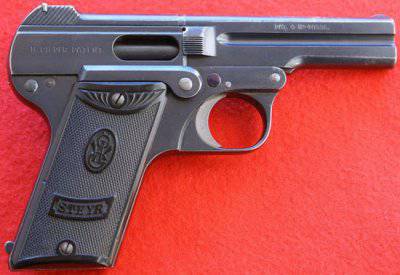 Like any designer, Piper wanted to create a weapon as convenient, cheap and reliable as possible. Apparently for this reason, one of the most common ammunition 7,65x17 (.32 ASR) was chosen at that time. Perhaps if the munition was chosen more powerful, the weapon would even be adopted by the army or the police, but since this cartridge was more suitable for the civilian market, and in the military environment they had long been eyeing more powerful ammunition, the weapon found its place in the civilian market. However, this gun was used by the Austrian police later, but as a personal weapon of the police, and not as a service weapon. As a matter of fact, Piper himself did not plan to create a pistol for the army, first of all the idea was to create a weapon fairly compact and lightweight while maintaining the normal length of the barrel and this gunsmith succeeded. A lot of attention was also paid to the ergonomics of the pistol and many still consider it one of the leading comfort in retention and use.
Like any designer, Piper wanted to create a weapon as convenient, cheap and reliable as possible. Apparently for this reason, one of the most common ammunition 7,65x17 (.32 ASR) was chosen at that time. Perhaps if the munition was chosen more powerful, the weapon would even be adopted by the army or the police, but since this cartridge was more suitable for the civilian market, and in the military environment they had long been eyeing more powerful ammunition, the weapon found its place in the civilian market. However, this gun was used by the Austrian police later, but as a personal weapon of the police, and not as a service weapon. As a matter of fact, Piper himself did not plan to create a pistol for the army, first of all the idea was to create a weapon fairly compact and lightweight while maintaining the normal length of the barrel and this gunsmith succeeded. A lot of attention was also paid to the ergonomics of the pistol and many still consider it one of the leading comfort in retention and use. 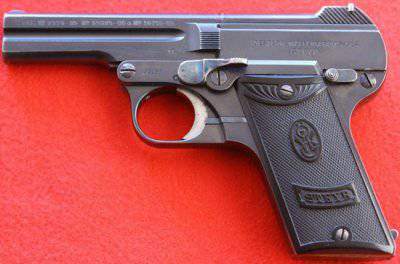 Although, on the other hand, ergonomics is very, very individual and that it is convenient for one person, it is not always convenient for another, although on the whole the angle of inclination of the handle and the arrangement of the controls seem to be well thought out. The release of weapons was adjusted by Steyr after several minor improvements. So the length of the barrel, and accordingly the length of the weapon, were changed, the aiming devices were reduced (in vain), the method of fastening the pads on the handle was changed. It is also mentioned in some sources that Steyr removed the bolt delay, but if you look closely at the patent, it is not there, maybe it appeared already after receiving the patent by Pieper, in any case, it would not have prevented this weapon in view of the relatively small magazine capacity.
Although, on the other hand, ergonomics is very, very individual and that it is convenient for one person, it is not always convenient for another, although on the whole the angle of inclination of the handle and the arrangement of the controls seem to be well thought out. The release of weapons was adjusted by Steyr after several minor improvements. So the length of the barrel, and accordingly the length of the weapon, were changed, the aiming devices were reduced (in vain), the method of fastening the pads on the handle was changed. It is also mentioned in some sources that Steyr removed the bolt delay, but if you look closely at the patent, it is not there, maybe it appeared already after receiving the patent by Pieper, in any case, it would not have prevented this weapon in view of the relatively small magazine capacity.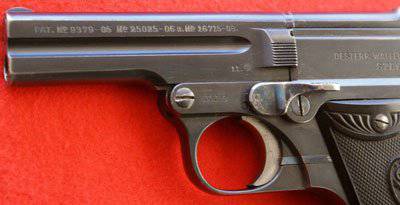 The appearance of the gun is not quite usual and familiar in comparison with modern samples, which is not surprising, because at that time the designers were not tied to any canons and rules, but created them themselves. Immediately striking is the small thickness of the weapon, although at the expense of individual protruding elements the weapon is still not as flat as it seems. The designer was able to achieve a small thickness at the expense of not quite the usual layout. The fact is that, conditionally, the gun can be divided into three parts: A barrel with a return spring, a frame and a bolt that seems too small and light even for such a weak cartridge. But everything works perfectly and without any complaints, but the details are a bit lower. The controls are quite familiar, that what, and the designers did not have to reinvent it. The release key is closed by a rather large safety clip, which allows the gun to be used in hands protected by gloves. The safety switch is located on the left side of the weapon frame. The switch itself is made quite small detail, which is not in favor of the dimensions of the weapon due to the overlays on the handle and the tides on the frame itself. The location of the fuse switch by modern standards is not the best, since you cannot remove a weapon from the fuse with your right thumb while holding the pistol. Also on the left side of the weapon is a lever that locks the hinged block of the barrel and the return spring, that is, a lever for disassembling the weapon.
The appearance of the gun is not quite usual and familiar in comparison with modern samples, which is not surprising, because at that time the designers were not tied to any canons and rules, but created them themselves. Immediately striking is the small thickness of the weapon, although at the expense of individual protruding elements the weapon is still not as flat as it seems. The designer was able to achieve a small thickness at the expense of not quite the usual layout. The fact is that, conditionally, the gun can be divided into three parts: A barrel with a return spring, a frame and a bolt that seems too small and light even for such a weak cartridge. But everything works perfectly and without any complaints, but the details are a bit lower. The controls are quite familiar, that what, and the designers did not have to reinvent it. The release key is closed by a rather large safety clip, which allows the gun to be used in hands protected by gloves. The safety switch is located on the left side of the weapon frame. The switch itself is made quite small detail, which is not in favor of the dimensions of the weapon due to the overlays on the handle and the tides on the frame itself. The location of the fuse switch by modern standards is not the best, since you cannot remove a weapon from the fuse with your right thumb while holding the pistol. Also on the left side of the weapon is a lever that locks the hinged block of the barrel and the return spring, that is, a lever for disassembling the weapon. 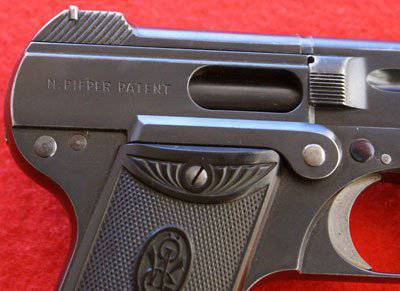 Unlike the fuse switch, this element is made quite large. Considering the fact that they were far from being used so often, it could have been made more compact. Gun sights are the usual unregulated sight and front sight and do not stand out in any way. Also not the most successful control, in my opinion, is the lever of fixing the weapon shop, which is located on the back side of the pistol grip. There is an assumption that if the shooter has sufficiently large palms, he can easily press this lever by accident, which will lead to the removal of the magazine. Since the axis of the barrel is located below the axis of the return spring, the designer had to make a window for ejection of spent cartridges in the frame of the pistol. This window is located on the right side of the weapon, it is large enough so that the sleeve flies out through it steadily and with a whistle. We should also mention the convenience of reloading weapons, which is actually absent, since the bolt itself is very small, respectively, and the area with the texture for the grip when the bolt is pulled back is small. And although, in general, there are no special problems when the bolt is retracted, it will be difficult to perform this action in the same thick gloves, despite the fact that the notch on the bolt is deep enough. Pads on the arms of the weapon are thick, made of black plastic. If you look from the position of compactness, you can consider thick lining as a significant minus, if no “but”. This “but” lies in the fact that the gun has many other protruding elements increasing its overall thickness, so that the thick plastic of the handle linings in a particular case can only be viewed positively, since it is precisely thanks to the plates that the retention of the weapon is quite comfortable. As mentioned earlier, the axis of the barrel of the gun is located below the axis of the return spring, for this reason, the muzzle does not look quite usual. The one on whom the weapon will be aimed will see the hole in the barrel, and above it the cap of the bolt that holds the return spring in its channel, preventing it from escaping beyond the weapon. Immediately it should be noted that the load on the cover of the return spring channel is minimal.
Unlike the fuse switch, this element is made quite large. Considering the fact that they were far from being used so often, it could have been made more compact. Gun sights are the usual unregulated sight and front sight and do not stand out in any way. Also not the most successful control, in my opinion, is the lever of fixing the weapon shop, which is located on the back side of the pistol grip. There is an assumption that if the shooter has sufficiently large palms, he can easily press this lever by accident, which will lead to the removal of the magazine. Since the axis of the barrel is located below the axis of the return spring, the designer had to make a window for ejection of spent cartridges in the frame of the pistol. This window is located on the right side of the weapon, it is large enough so that the sleeve flies out through it steadily and with a whistle. We should also mention the convenience of reloading weapons, which is actually absent, since the bolt itself is very small, respectively, and the area with the texture for the grip when the bolt is pulled back is small. And although, in general, there are no special problems when the bolt is retracted, it will be difficult to perform this action in the same thick gloves, despite the fact that the notch on the bolt is deep enough. Pads on the arms of the weapon are thick, made of black plastic. If you look from the position of compactness, you can consider thick lining as a significant minus, if no “but”. This “but” lies in the fact that the gun has many other protruding elements increasing its overall thickness, so that the thick plastic of the handle linings in a particular case can only be viewed positively, since it is precisely thanks to the plates that the retention of the weapon is quite comfortable. As mentioned earlier, the axis of the barrel of the gun is located below the axis of the return spring, for this reason, the muzzle does not look quite usual. The one on whom the weapon will be aimed will see the hole in the barrel, and above it the cap of the bolt that holds the return spring in its channel, preventing it from escaping beyond the weapon. Immediately it should be noted that the load on the cover of the return spring channel is minimal.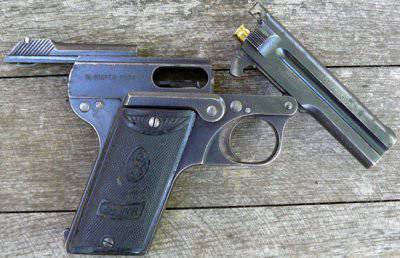 Now let's try to figure out how it all works. In view of the fact that a rather weak ammunition is used in the pistol, the automatic pistol is built according to the free-bolt scheme. However, the designer applied several not quite standard solutions in his weapon, making it unique in its own way. First of all, you need to pay attention to how the bolt, which is light enough even for such an ammunition, interacts with the return spring. The return spring itself is located above the barrel, a guide passes through it, which at one end has an abutment to compress the spring, and at the other end a peculiar hook that the bolt clings to with its protrusion. It is noteworthy in this all that the automatic system of the pistol is working “incorrectly”. So instead of the fact that the powder gas gave only the initial energy of the gate, which he would have retained due to its mass, they completely accompany the whole process of reloading the gun. So, when fired, the powder gases push the bullet forward, and the bolt through the sleeve back, when the sleeve is completely out of the chamber, it is ejected through the right window to eject the sleeves. What is remarkable is that the shutter does not even have an ejector. The shutter itself, despite its low weight, is still moving for a short time on its own, continuing to compress the return spring and reaching its extreme rear position. After that, under the action of a return spring, the bolt returns to its original position, picking up a new cartridge from the magazine. Naturally, such an operation of the automation scheme does not give positive results in shooting accuracy, because the designer decided to compensate for this drawback using a non-standard layout. The main advantage of the layout of the parts of this gun is that the barrel axis is lower than in the weapon models we are used to, as a result of this the return will exactly hit the shooter’s hand, although it’s strange to talk about recoil for the .32ACP cartridge, it seems but it seems not. It is also important that due to this design, the mass of the moving parts of the gun during the shot is minimal, which, in turn, has a positive effect on the accuracy of shooting. As a result, the "minus" overlap several "pluses", and since this is not about mathematics, the weapon in the end result was quite accurate. Immediately it should be noted that with a more powerful ammunition such a trick would not work.
Now let's try to figure out how it all works. In view of the fact that a rather weak ammunition is used in the pistol, the automatic pistol is built according to the free-bolt scheme. However, the designer applied several not quite standard solutions in his weapon, making it unique in its own way. First of all, you need to pay attention to how the bolt, which is light enough even for such an ammunition, interacts with the return spring. The return spring itself is located above the barrel, a guide passes through it, which at one end has an abutment to compress the spring, and at the other end a peculiar hook that the bolt clings to with its protrusion. It is noteworthy in this all that the automatic system of the pistol is working “incorrectly”. So instead of the fact that the powder gas gave only the initial energy of the gate, which he would have retained due to its mass, they completely accompany the whole process of reloading the gun. So, when fired, the powder gases push the bullet forward, and the bolt through the sleeve back, when the sleeve is completely out of the chamber, it is ejected through the right window to eject the sleeves. What is remarkable is that the shutter does not even have an ejector. The shutter itself, despite its low weight, is still moving for a short time on its own, continuing to compress the return spring and reaching its extreme rear position. After that, under the action of a return spring, the bolt returns to its original position, picking up a new cartridge from the magazine. Naturally, such an operation of the automation scheme does not give positive results in shooting accuracy, because the designer decided to compensate for this drawback using a non-standard layout. The main advantage of the layout of the parts of this gun is that the barrel axis is lower than in the weapon models we are used to, as a result of this the return will exactly hit the shooter’s hand, although it’s strange to talk about recoil for the .32ACP cartridge, it seems but it seems not. It is also important that due to this design, the mass of the moving parts of the gun during the shot is minimal, which, in turn, has a positive effect on the accuracy of shooting. As a result, the "minus" overlap several "pluses", and since this is not about mathematics, the weapon in the end result was quite accurate. Immediately it should be noted that with a more powerful ammunition such a trick would not work.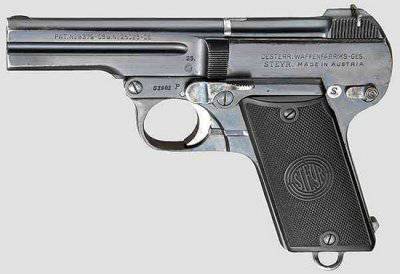 The positive qualities of the weapon include its high accuracy and comfort of firing, for which you need to thank the well-thought-out ergonomics of the pistol grip, and the low-power cartridge and the layout of the weapon. The weight and dimensions of the weapon are also an undeniable advantage. So, the gun weighs only 630 grams with a 162 millimeter length and a 92 millimeter barrel length. Non-standard solutions in the design of weapons can also be attributed to positive features, but there is more positive for the development of firearms in general, rather than the specific positive features of this model of weapon. In addition, the ease of maintenance of the weapon is highlighted separately, since an incomplete disassembly of the pistol for cleaning is quite simple and at the same time all parts of the pistol remain in place, which is only a plus when cleaning the weapon in field conditions. So if the cartridge in this pistol was “stricter”, this sample would surely interest the military and one country would not do.
The positive qualities of the weapon include its high accuracy and comfort of firing, for which you need to thank the well-thought-out ergonomics of the pistol grip, and the low-power cartridge and the layout of the weapon. The weight and dimensions of the weapon are also an undeniable advantage. So, the gun weighs only 630 grams with a 162 millimeter length and a 92 millimeter barrel length. Non-standard solutions in the design of weapons can also be attributed to positive features, but there is more positive for the development of firearms in general, rather than the specific positive features of this model of weapon. In addition, the ease of maintenance of the weapon is highlighted separately, since an incomplete disassembly of the pistol for cleaning is quite simple and at the same time all parts of the pistol remain in place, which is only a plus when cleaning the weapon in field conditions. So if the cartridge in this pistol was “stricter”, this sample would surely interest the military and one country would not do.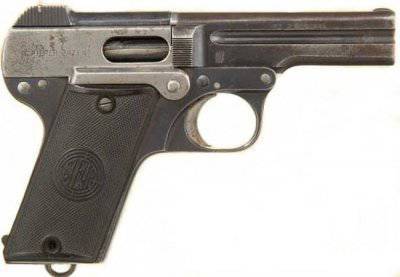 The negative qualities of a gun are much more. First of all, it is not the most powerful ammunition, which at that time, although relatively popular, was quickly survived by more effective and powerful cartridges. The second minus is the design of the weapon, which was such that making the weapon cheap was almost impossible. High requirements for fitting parts, quality of metal and so on affected the price, making it quite large. In addition, we must not forget that the automatic pistol worked "wrong", which means it was possible to observe increased wear. Returning back to the automatic weapons, it should be noted that many interesting solutions that have a positive effect on the characteristics of the gun were introduced only to compensate for errors in the design of the weapon. And although the end result is quite good, all the same, as they say, the sediment remained.
The negative qualities of a gun are much more. First of all, it is not the most powerful ammunition, which at that time, although relatively popular, was quickly survived by more effective and powerful cartridges. The second minus is the design of the weapon, which was such that making the weapon cheap was almost impossible. High requirements for fitting parts, quality of metal and so on affected the price, making it quite large. In addition, we must not forget that the automatic pistol worked "wrong", which means it was possible to observe increased wear. Returning back to the automatic weapons, it should be noted that many interesting solutions that have a positive effect on the characteristics of the gun were introduced only to compensate for errors in the design of the weapon. And although the end result is quite good, all the same, as they say, the sediment remained.After its appearance, the Steyr M1908 pistol was produced until the beginning of the First World War, after which its production was stopped. It was renewed only in 1934 year, although the weapon received a modified shutter, heavier with the ejector, respectively, and the automatic weapons began to work like a human. Basically, weapons were popular in the civilian market, one was used in limited quantities by the Austro-Hungarian police, and subsequently by the Austrian police. In addition to the full-size model of the pistol, a compact M1909 model was also created, which was distinguished not only by its dimensions, but also by the ammunition used (.25ACP). This gun was even less effective, but retained all the features of its older brother. But about this weapon in the next article.
Information